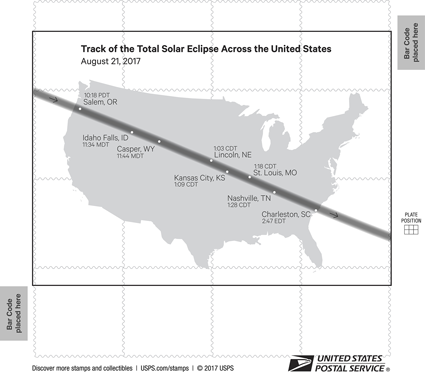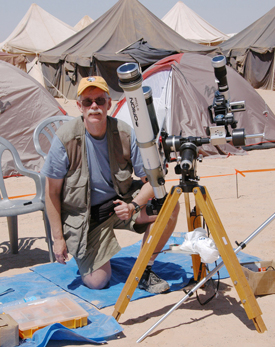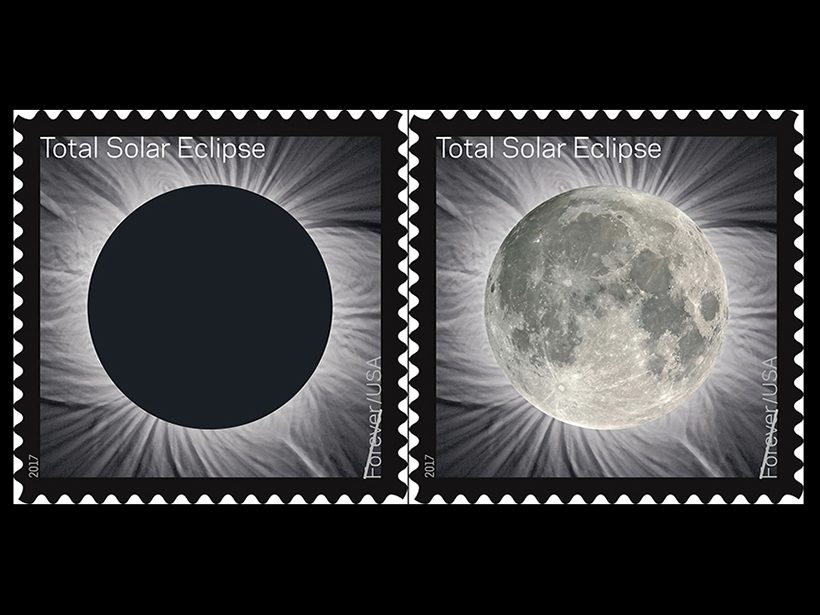The total solar eclipse pictured on a postage stamp being released today is a remarkably good representation of what hordes of eclipse watchers will see with their own eyes this August. So says astrophysicist Fred Espenak, who snapped the photos featured on the new stamp of the Sun and Moon.
The new stamp from the U.S. Postal Service (USPS) commemorates the 21 August total solar eclipse that will be viewable, weather permitting, along about a 110-kilometer-wide “path of totality” across the country from Oregon to South Carolina. This is the first time since 1979 that a total solar eclipse will be visible on the U.S. mainland. The postal service is rolling out the 49-cent “Forever” stamp, always worth the 1-ounce price for First Class Mail, on the cusp of the 2017 summer solstice.
Combining exposures taken at different camera shutter speeds and fine-tuning and filtering them on a computer brought out details of the solar atmosphere that otherwise would not be visible on a stamp.
To create the extraordinary stamp, the stamp’s designer used a composite image provided by Espenak of an earlier eclipse. Espenak’s image digitally stitched together 22 separate photographs that he took of a 2006 total solar eclipse in Libya. Combining exposures taken at different camera shutter speeds and fine-tuning and filtering them on a computer brought out details of the solar atmosphere that otherwise would not be visible on a stamp, according to Espenak, an eclipse expert, astrophysicist, and photographer. Espenak, who maintains NASA’s official eclipse website, has been dubbed by some as “Mr. Eclipse.”
The image that resulted from those sophisticated techniques shows exceptionally fine gradations of light and dark, so it comes close to representing what the Sun’s corona looks like to the naked eye, explained Espenak, who retired from NASA’s Goddard Space Flight Center in Greenbelt, Md., after working there as an astrophysicist for more than 30 years.
“The inner part of the corona is 1000 times brighter than the outer corona [that is] just a Sun’s diameter away,” Mr. Eclipse said. “The eye can see that beautifully but photographs don’t reveal that” unless they undergo special processing.
Here’s the Rub
But that’s not all that’s exceptional about this stamp.
If you touch the eclipse image on the stamp, the heat from your finger temporarily reveals an image of the full Moon (also shot by Espenak) covering the disk of the Sun. This effect is made possible with thermochromic ink that changes the stamp’s look in response to temperature, the first time USPS has used this technique.
USPS encourages postage stamp art directors to think of new approaches to subject matter that can enhance the stamp program, according to Antonio Alcalá, owner and creative director of Studio A in Alexandria, Va., who designed this stamp.

“I believe a primary experience of a solar eclipse is the rapid transition from daylight to darkness to daylight again,” Alcalá told Eos. “Having seen thermochromic printing a few times in the past, I thought this technique might be suitable for conveying this general idea.”
Contributing as well to the visual impact of these stamps, the postal service is printing them in a four-color process. This printing method achieves a richer black because less light reflects from the sheet of paper and allows for a greater range of tonality, Alcalá explained.
The flip side of each pane with 16 of the new stamps shows a map of the United States crossed by the path of totality and gives the times of the total solar eclipse at each location specified on the map from Salem, Ore., to Charleston, S.C.
USPS issued a much more traditional eclipse stamp in 2000. Other countries also have issued eclipse stamps in the past, including Mexico, Zimbabwe, and Libya.
Reaching Millions of People
Espenak told Eos that, sure, he’s thrilled about his images being used on the stamp, but he’s also excited to inform and educate millions of people about an astronomical phenomenon. A solar eclipse is “one of the most spectacular ways” to reach out to the public and get them interested in science and technology, he said.
Seeing a total solar eclipse “is a life-changing event.”
“The United States in particular is suffering from severe science illiteracy right now,” Espenak said. “It’s heartbreaking seeing the way the leadership in this country is taking us away from science.”
Seeing a total solar eclipse “is a life-changing event,” said Espenak, who looks forward to the August incident as his 28th such experience, noting that he has “only” spent about 70 minutes overall in totality. Espenak said that nothing—not videos, books, or photos—can prepare somebody for the sensation of witnessing a total eclipse in person.
“When that moon shadow comes over the horizon and suddenly sweeps over [the Sun], you plunge from bright daylight into twilight in seconds,” he said. “You feel this event in the pit of your stomach, you feel it on the hair on your arms and the back of your neck. You have a visceral reaction that something is very different, something is very wrong, even.”
Because “it seems apocalyptic” with the Sun’s bright disk briefly gone, “you can easily empathize with people thousands of years ago who didn’t understand what was happening,” he added.
Espenak took the video below of the 1 August 2008 total solar eclipse from Jinta, China. “Consider this an appetizer for the 2017 total solar eclipse through the USA,” he writes in notes accompanying the video.
Total Solar Eclipse of 2008 – 1 from Fred Espenak on Vimeo.
Chasing Eclipses
Espenak caught his first total solar eclipse in 1970 when, at age 18 with a newly issued driver’s license, his parents allowed him to drive the family’s blue Chevy Biscayne, unchaperoned, about 750 kilometers from Staten Island, N.Y., to Windsor, N.C., to get in the path of the eclipse. He checked into a motel, and the next morning on eclipse day, the area behind the motel “was a field of tripods. Everybody was there in that motel to see the eclipse. It was like a big party there.”

“I’m really wound up on eclipse day,” said Espenak, who leads eclipse tours. There are so many cameras to set up and align that must be “coordinated almost like a ballet,” he said. On eclipse day, he’s not very social, cordoning off his staging area with police tape as a visual warning to others not to disturb him or his equipment.
“A number of TV stations have said they wanted to interview me during the eclipse, and I said, ‘Are you out of your mind?’” Espenak said. “You can’t pay me enough, not during the eclipse.”
The August eclipse will be another nerve-wracking time for Espenak. A few days prior, he’ll talk about the eclipse at an astronomy convention in Casper, Wyo., which lies in the path of totality. However, if the forecast calls for clouds in Casper, he will be ready to drive an SUV full of photo equipment as far as he can along that path, the day before the eclipse, looking for better weather. That makes sense for Espenak, who said that seeing total eclipses “has been the biggest thrill of my life.”
—Randy Showstack (@RandyShowstack), Staff Writer
Citation:
Showstack, R. (2017), Innovative postage stamp celebrates upcoming total solar eclipse, Eos, 98, https://doi.org/10.1029/2017EO076427. Published on 20 June 2017.
Text © 2017. The authors. CC BY-NC-ND 3.0
Except where otherwise noted, images are subject to copyright. Any reuse without express permission from the copyright owner is prohibited.

